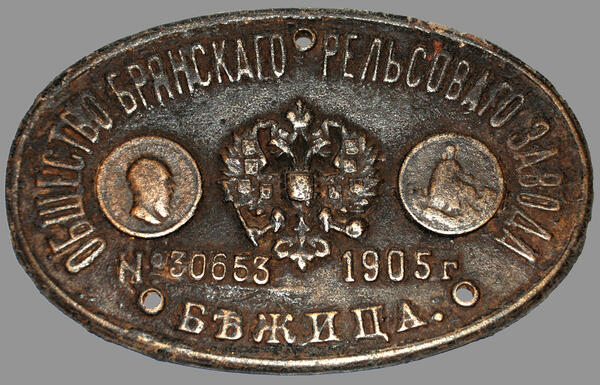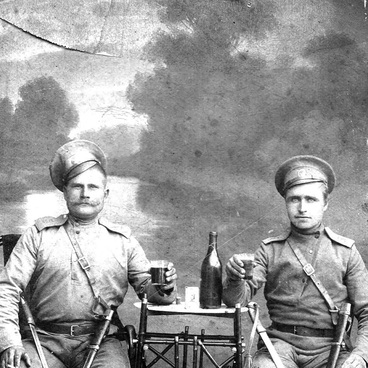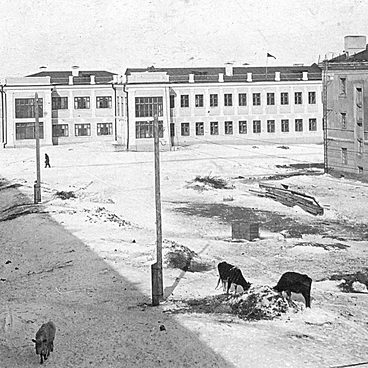The plaque represents the work undertaken by the Orenburg Cossack troops in the construction of railway lines. Whereas in time of peace its construction was justified by economic needs, in civil war it was motivated by the needs of the army. By the beginning of the Civil War, Orsk was a city with a railway station, but without a railroad. The railway line ‘Orenburg - Orsk’ was brought to the station Sara, only 50 km from Orsk, and the line ‘Troitsk - Orsk’ – to the station Kartaly, from which there were 375 versts left to Orsk.
One of the most pressing tasks facing the ataman Alexander Ilyich Dutov was to connect the territory of the Orenburg Cossack Troops and the base of the White Movement in Siberia by the railroad, which required the completion of the Orenburg-Orsk and Trinity-Orsk railroads. This task was strategically important for proper provision of the entire left flank of the Eastern Front of the Whites, as well as for supplying the population of the Southern Urals with everything they needed. In the absence of this road, to get from Chelyabinsk County to Orenburg County, instead of 250-600 versts in a straight line one had to make a hook of 1500-2000 versts. In October 1918, when the white station Kinel (near Samara) was abandoned, Orenburg was deprived of even this route. The task of completing the railroad could not be solved only at the local level, and the assistance of the Omsk government was needed. Dutov made a lot of efforts to secure funding for this project. He petitioned the Ministry of Finance for the allocation of 9 million rubles for this project. In December 1918, the petition was granted, but the project was never fully implemented.
By the spring of 1919, the Whites had laid 115 versts of tracks from the station Kartaly and brought the rails almost to the station Baituk. The line was built without an embankment from Breda station to Baituk station. In 1918, they opened a working movement on the section Kartaly - Breda - Baituk. There were not enough rails to close the section Baituk-Orsk though. The Orenburg - Orsk railway was being completed. The documents of the Orenburg Cossack troops mentioned a military engineer Warrant Officer G.E. Bandrovsky, sent in October 1918 to lay the rail track from the station Sara to the station Orsk. By December 20, 1918, 40 versts were laid on the section Sarah - Krutorozhino, but most likely, it was never used.
As for the plaque of the Briansk Railway Factory Association, it was attached to a car or a locomotive, which were produced by this enterprise along with the rails. Cars and locomotives produced by the Bryansk plant were used on the completed sections of the railway in the Orenburg region.
One of the most pressing tasks facing the ataman Alexander Ilyich Dutov was to connect the territory of the Orenburg Cossack Troops and the base of the White Movement in Siberia by the railroad, which required the completion of the Orenburg-Orsk and Trinity-Orsk railroads. This task was strategically important for proper provision of the entire left flank of the Eastern Front of the Whites, as well as for supplying the population of the Southern Urals with everything they needed. In the absence of this road, to get from Chelyabinsk County to Orenburg County, instead of 250-600 versts in a straight line one had to make a hook of 1500-2000 versts. In October 1918, when the white station Kinel (near Samara) was abandoned, Orenburg was deprived of even this route. The task of completing the railroad could not be solved only at the local level, and the assistance of the Omsk government was needed. Dutov made a lot of efforts to secure funding for this project. He petitioned the Ministry of Finance for the allocation of 9 million rubles for this project. In December 1918, the petition was granted, but the project was never fully implemented.
By the spring of 1919, the Whites had laid 115 versts of tracks from the station Kartaly and brought the rails almost to the station Baituk. The line was built without an embankment from Breda station to Baituk station. In 1918, they opened a working movement on the section Kartaly - Breda - Baituk. There were not enough rails to close the section Baituk-Orsk though. The Orenburg - Orsk railway was being completed. The documents of the Orenburg Cossack troops mentioned a military engineer Warrant Officer G.E. Bandrovsky, sent in October 1918 to lay the rail track from the station Sara to the station Orsk. By December 20, 1918, 40 versts were laid on the section Sarah - Krutorozhino, but most likely, it was never used.
As for the plaque of the Briansk Railway Factory Association, it was attached to a car or a locomotive, which were produced by this enterprise along with the rails. Cars and locomotives produced by the Bryansk plant were used on the completed sections of the railway in the Orenburg region.



